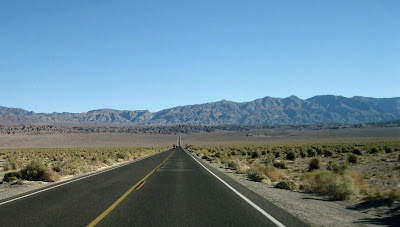.jpg) Looking into the mouth of Natural Bridge Canyon
Looking into the mouth of Natural Bridge CanyonAfter leaving hell, oops I mean Furnace Creek, we attended an afternoon guided Ranger walk to learn more about the geology in Death Valley National Park Natural Bridge Canyon.
.jpg) Ranger Bob at mouth of Natural Bridge Canyon
Ranger Bob at mouth of Natural Bridge CanyonRanger Bob is a retired geologist working summers at Yellowstone and winters at Death Valley for the last 10 years. He not only knew his stuff, he got everybody into it.
.jpg) View west of Death Valley and Panamint Range from Natural Bridge Canyon
View west of Death Valley and Panamint Range from Natural Bridge CanyonAlthough Death Valley itself is young in geologic time, formed a mere three million years ago, some of the rocks that makes up the rugged mountains to the east of the valley date back to around 1.8 billion years old.
.jpg) Gneiss old rock
Gneiss old rockUplift began about 8-10 million years ago but most of the drastic elevation change occurred in the last 3 million years.
.jpg) Natural Bridge Canyon
Natural Bridge CanyonFour mountain ranges to the west of the valley create such a strong rain shadow that the average precipitation is less than two inches a year. Death Valley is considered the driest place in North America. Yet during unusually heavy storms, rain washes rocks, sand and gravel off mountainsides and down into canyons.
.jpg) Multiple alluvial fans
Multiple alluvial fansWhere a canyon opens onto the valley floor the water spreads out, losing velocity and depositing the water-carried material at the canyon mouth, or beyond, creating an alluvial fan. As the mountains lift the valley sinks. Yet erosion can’t keep up as the valley sinks faster than it fills. Even after millions of floods, nearly 9000 feet (2750 meters) of sand, silt, gravel and salt fill the valley basin.
.jpg) Water erosion on canyon wall
Water erosion on canyon wallBecause this erosion process has been going on for millions of years some rock layers are concentrations of rock, sand and gravel compressed by more layers into an interesting conglomerate like was seen in Mosaic Canyon.
.jpg) Ranger Bob at Natural Bridge
Ranger Bob at Natural BridgeAnd then there are numerous faults as this land known as the “Basin and Range” spreads apart fracturing along parallel fault lines creating the Panamint Mountains to the west and the Black Mountains to the east with Badwater Basin in between. A large earthquake could cause the valley in between to drop a few more feet below sea level.

.jpg)
.jpg)
.jpg)
.jpg)
.jpg)
.jpg)

.jpg)
.jpg)
.jpg)
.jpg) The giant wheels were protected with steel tires eight inches wide and an inch thick which had to be replaced regularly. Two men rode the wagons, driver and swamper, and traveled 15 to 17 miles (24 to 27 km) a day. Waterholes were 50 miles (80 km) apart with dusty, rocky, sandy ruts for roads in between.
The giant wheels were protected with steel tires eight inches wide and an inch thick which had to be replaced regularly. Two men rode the wagons, driver and swamper, and traveled 15 to 17 miles (24 to 27 km) a day. Waterholes were 50 miles (80 km) apart with dusty, rocky, sandy ruts for roads in between..jpg)
.jpg) Borax has long been used for every kind of household cleaning from windows to tile grout. It is also a component of cosmetics, insecticide, glass, pottery and enamel glazes. It is used as a food additive or preservative in some countries yet is banned in the US.
Borax has long been used for every kind of household cleaning from windows to tile grout. It is also a component of cosmetics, insecticide, glass, pottery and enamel glazes. It is used as a food additive or preservative in some countries yet is banned in the US..jpg) Some of the workers from Harmony Borax Works lived in nearby
Some of the workers from Harmony Borax Works lived in nearby